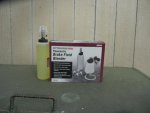- 849
- 1,740
- 93
- Location
- N. Central Idaho
So I changed the flex hoses in my brake system until such time I can move to a dual system and/or get steel braided hoses. I bought a vacuum bleeder, a cheap one. I started at the right rear brake and went through 3 quarts without getting a solid stream without bubbles; more bubbles than fluid. Then I thought maybe the bleed screw was leaking so I moved over to the LH rear. Same thing. 2 quarts later I give up for the day. It did cycle all the old fluid out but never stopped producing bubbles. The old fluid was very dark and smelled like rubber. DOT3 BTW. I did have trouble getting the lines loose as they were really frozen so I had to pull some hard lines so I could get a good grip on the flex lines. I went back and check all connections for tightness.
Did I crack a hard line or something? Since I can't get them bled, how do I pressurize the system to check for leaks/cracked hard lines by observing leaks? I've always bled brakes with a soldier B so maybe I'm doing something wrong with the bleeder. It does not mention how much pressure so i started at 25 PSI and then went to 50 PSI. I'm afraid if I go too high I'll start pulling air through the wheel cylinders as I have read that does happens.
Open for suggestions/advice any/all help greatly appreciated.
Thanks in advance
Did I crack a hard line or something? Since I can't get them bled, how do I pressurize the system to check for leaks/cracked hard lines by observing leaks? I've always bled brakes with a soldier B so maybe I'm doing something wrong with the bleeder. It does not mention how much pressure so i started at 25 PSI and then went to 50 PSI. I'm afraid if I go too high I'll start pulling air through the wheel cylinders as I have read that does happens.
Open for suggestions/advice any/all help greatly appreciated.
Thanks in advance



